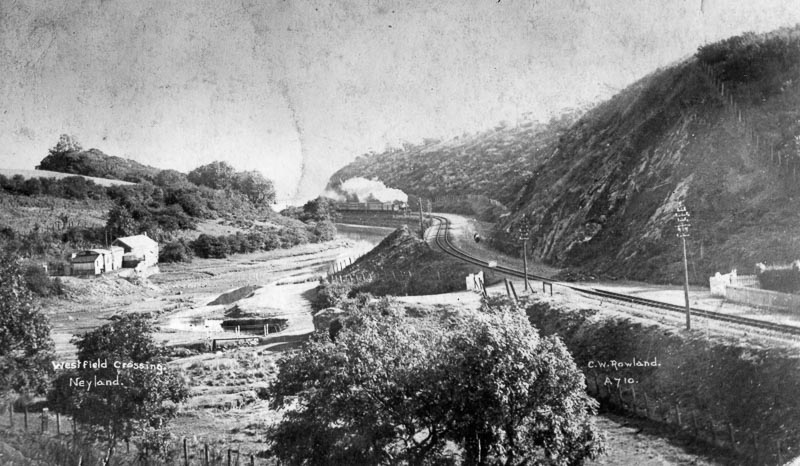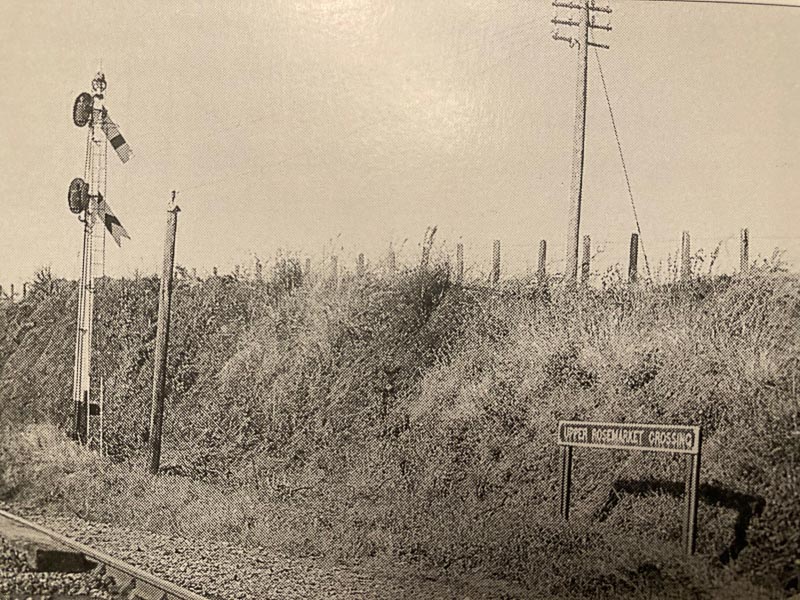In the 1850s the railway came to Rosemarket on route to Neyland where the vision of Isambard Kingdom Brunel was for a major ferry port linking with Ireland and the USA.
The construction of the double-track railway (down line and up line) took a lot of labour and several years to complete. This was a complicated process due to the undulating terrain and several small streams had to be traversed. Ducting and narrow tunnels had to be constructed beneath the track.
Agreements were reached with local landowners. One such agreement was to find a solution for maintaining the flow of water to Norton Mill, now long gone, which was near the railway bridge on Norton Hill road.
In another example, a large arch was constructed beneath the track between Middle Crossing and Westfield Mill. This was specifically for the farmers at Norton and others to the west so that when the railway was built across the route, they could bring cattle into the fields at Rosemarket whenever necessary. Historically within the village, this has always been known as the cattle arch.
The line from Haverfordwest through Johnston and Rosemarket to Neyland was opened to traffic in 1856. In 1863, the Great Western Railway (GWR) took over control from the South Wales Railway Company.
Separately, a line to Milford Haven from Johnston was opened in 1865. This followed a route through the western end of the parish after branching from the Neyland track a short distance north of the Rosemarket boundary.

Keeping the railway safe
At intervals along the track there were permanent workmen’s sheds. As safety was always a priority, these were bases for the teams of people keeping the track clear of vegetation and foliage on a regular basis and were also used to store the equipment needed. Keeping the tracks clear was crucial as it prevented any sparks from the engines setting fire to the surrounding areas. All the workmen’s sheds were demolished upon closure of the railway.
There was a gradual incline on the railway track through the village and upwards to Johnston. During the winter months, there was the added hazard of ice on the track and slippery conditions. Containers were therefore positioned periodically alongside the track and kept filled with material to use on the rails when needed in such conditions.
Crossing points
There were three crossing points for horses & carts and farm traffic within the village. These were named Westfield Mill, Middle Crossing and Upper Crossing. There were purpose-built cottages located at each crossing point, which housed the crossing-keepers and their families. The crossing-keepers maintained the crossing points and controlled the signalling and gating systems. Some families lived in the cottages for generations, passing on the crossing-keeper responsibilities to younger family members.

In the early decades of the railway through the village, crossing traffic would have been horse-drawn carts, farmers and their animals, and pedestrians. In later years, as motor transport developed and car ownership increased, the duties of the crossing-keepers would have increased significantly.
Over the years, there were a number of incidents recorded on the railway through Rosemarket. One such incident involved a lady being killed on the track whilst crossing towards the village shop to buy oil for her lamps. On another occasion, a man believed to be out hunting rabbits was knocked down and killed early one morning by a passing train from Johnston. There were also several small derailment incidents.
The Beauty of Steam
Lots of standard British Rail steam locomotives passed through Rosemarket, with a range of carriages and transport trucks. Diesel traffic only came in during the latter years of operation.
The passing of steam trains through the village was a visual spectacle – set against the beautiful Pembrokeshire countryside with the smoke billowing behind when steaming up from Neyland. Residents recall when relatives were working the trains as drivers or firemen, how they often sounded the horns when passing through the village. Many residents also remember waving to the drivers and passengers from the fields adjacent to the track.
An important feature in that earlier era was the need for water for the steam engines. A scheme to provide this water for Neyland terminal was linked to Rosemarket and Westfield Mill. The scheme involved diverting the river and creating a large pond and a pumping station (powered by coal) alongside the Pill with large water reservoirs on top of the hill opposite, to the west of the track. From here, water gravitated down to storage tanks at Neyland for the steam engines and also provided a source of water for the houses of Neyland railwaymen.
Changing times
The railway line was very busy with freight and passenger traffic for many years. Sadly, into the early twentieth century, the sea traffic ceased at Neyland when the ferry terminal closed and a new ferry terminal for Irish trade opened at Fishguard. This resulted in far less demand for the railway line through Rosemarket and on to Neyland.
During the First World War, one of the tracks was removed to help with the war effort, and it became a single-line track thereafter. Operation of a single-line track had challenges of its own, with a safe system of signalling needed to prevent two trains approaching from either end and colliding head-on. The system used was one that was popular across Britain’s railways and effectively involved the passing of a ‘key’ between engine drivers. Without the key, the train could not enter the track.
Despite the wishes of residents and repeated efforts by the Parish Council until as late as the 1930s, Rosemarket never achieved the status of a Halt (a railway station with minimal facilities where trains will usually stop only on request). Some residents do however recall that on occasions, the trains would unofficially stop at one of the crossing points to allow passengers to quickly get off and walk to the village.
Queen Elizabeth II
In the years following her coronation in 1953, Queen Elizabeth II, accompanied by Prince Phillip, embarked on a coronation tour of the UK. They came by train to West Wales and on this occasion, in August 1955, the Royal train passed through Rosemarket bringing the royal couple to Neyland.
Present-day
Today, only two of the original three crossing keepers cottages remain, both of which have been substantially modernised. The former cottage at Middle Crossing has been demolished and is now a large car parking area. The old railway lines have become pathways and cycle tracks, used by walkers, dog walkers and cyclists alike. In some locations along the route, some of the old boundary fence line from the GWR era remains, although mainly new fences have been installed much nearer to the old railway route than originally.
Brunel is said to have scattered seeds of quaking grass along the tracks he built as he believed its roots kept the ballast stable. It is believed this grass still grows north of the Upper Crossing. A memorial statue to Isambard Kingdom Brunel now stands in Neyland at the site of the old railway terminal, a few miles from Rosemarket.
Upper Crossing Cottage |